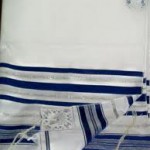Stripes on the tallit – Ask the Rabbi
Q. Why does a tallit sometimes have blue stripes?
 A. The combination of blue and white has a long history.
A. The combination of blue and white has a long history.
When the commandment of wearing fringes on one’s garments was given, a thread of blue had to be inserted in each corner (Num. 15:37-51). The rabbis explained that the blue is like the sea, the sea is like the heavens, and the heavens are like the Throne of Glory.
The particular shade of blue in the fringes was techelet, deriving from a dye obtained from a small sea creature known as a “chillazon”. Since this is no longer available (though some scholars have claimed that they have succeeded in replicating the techelet), tallitot and tzitziyot have only white threads, but a reminder of the techelet comes in the blue stripes on some tallitot.
(It is possible that the black stripes on tallitot worn particularly by Ashkenazim derive from the Rambam’s view that the colour of techelet is actually closer to black, rather than blue.)
Blue figures in a number of other historical contexts. It was part of the décor of the Tabernacle in the wilderness. The tablets of the Ten Commandments were housed in an ark covered by a cloth of blue.
In Persian synagogues, blue was the standard colour of the Ark covers and the Torah mantles, perhaps because the Middle Eastern environment attributed protective powers to blue.
In the Mishnah B’rachot, the sages speak about not saying the Shema in the morning until there is enough natural light to tell the difference between blue and white.
Even before the political Zionist movement came into being, suggestions were made, e.g. by the Viennese poet Ludwig August Frankl, that the Jewish flag should be blue and white. A Zionist society in Boston actually displayed in 1891 a flag with two blue stripes on a white background with the Magen David in the centre.
One of the great Zionist pioneers, David Wolffsohn, said the Zionist flag should follow the design of the tallit, which he declared to be the age-old flag of the Jewish people.
Herzl liked the idea of a flag; when critics said a flag was just a piece of cloth on a pole, he said, “Yes – but with a piece of cloth on a pole you can lead people anywhere, even to the Promised Land!”



